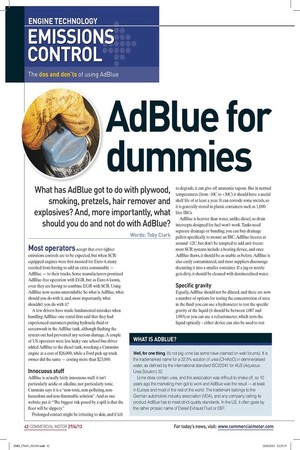AdBlue for dummies What has AdBlue got to do with
Page 34

Page 35

If you've noticed an error in this article please click here to report it so we can fix it.
plywood, smoking, pretzels, hair remover and explosives? And, more importantly, what should you do and not do with AdBlue?
Words: Toby Clark Most operators accept that ever-tighter emissions controls are to be expected, but when SCRequipped engines were first mooted for Euro-4, many recoiled from having to add an extra consumable — AdBlue — to their trucks. Some manufacturers promised AdBlue-free operation with EGR, but as Euro-6 looms, even they are having to combine EGR with SCR. Using AdBlue now seems unavoidable. So what is AdBlue, what should you do with it, and, most importantly, what shouldn't you do with it?
A few drivers have made fundamental mistakes when handling AdBlue: one rental firm said that they had experienced customers putting hydraulic fluid or screenwash in the AdBlue tank, although flushing the system out had prevented any serious damage. A couple of US operators were less lucky: one school bus driver added AdBlue to the diesel tank, wrecking a Cummins engine at a cost of $26,000, while a Ford pick-up truck owner did the same — costing more than $23,000.
Innocuous stuff AdBlue is actually fairly innocuous stuff: it isn't particularly acidic or alkaline, nor particularly toxic. Cummins says it is a "non-toxic, non-polluting, nonhazardous and non-flammable solution". And as one website put it: "The biggest risk posed by a spill is that the floor will be slippery."
Prolonged contact might be irritating to skin, and if left to degrade, it can give off ammonia vapour. But in normal temperatures (from -10C to +30C) it should have a useful shelf life of at least a year. It can corrode some metals, so it is generally stored in plastic containers such as 1,000litre TBCs.
AdBlue is heavier than water, unlike diesel, so drain intercepts designed for fuel won't work. Tanks need separate drainage or bunding; you can buy drainage pallets specifically to mount an IBC. AdBlue freezes at around -12C, but don't be tempted to add anti-freeze: most SCR systems include a heating device, and once AdBlue thaws, it should be as usable as before. AdBlue is also easily contaminated, and most suppliers discourage decanting it into a smaller container. If a jug or nozzle gets dirty, it should be cleaned with demineralised water.
Specific gravity Equally, AdBlue should not be diluted, and there are now a number of options for testing the concentration of urea in the fluid: you can use a hydrometer to test the specific gravity of the liquid (it should be between 1.087 and 1.093) or you can use a refractometer, which tests the liquid optically — either device can also be used to test anti-freeze. A digital refractometer makes testing quicker and more precise, but costs around £300 rather than £40. There are also test strip kits that can show if AdBlue has been contaminated with diesel.
Can you do without AdBlue altogether? Well, no: the SCR system won't work properly and will show a fault code that could be picked up at an inspection. Some firms are marketing AdBlue removal kits or AdBlue emulator boxes, which are claimed to bypass the SCR system and allow the engine to work without any error codes or change in operation — manufacturers claim that a truck can even get through its MoT with the unit in place. However, the small print always states that they are for "off-road or race use only" or for "export purposes outside the EU" .
And finally: if you run out of AdBlue on the road, don't be tempted to relieve yourself in the tank. Normal human urine should only contain around 1% urea, so if the SCR works normally after that, you've got real problems... •








































